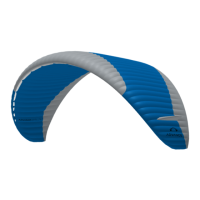
Do you have a question about the Advance acoustic EPSILON 8 Series and is the answer not in the manual?
| Brand | Advance acoustic |
|---|---|
| Model | EPSILON 8 Series |
| Category | Aircrafts |
| Language | English |
Describes the balanced feel-good factor, precision, performance, and safety of the EPSILON 8.
Highlights the EPSILON 8's successful combination of pitch and turn behavior for confident piloting.
Details the robust, lightweight structure using European Porcher cloth and OMEGA XALPS technology.
Explains how three-liner design, double-3D-shaping, and smooth surfaces enhance performance.
Simplifies and speeds up harness connection with color-coded risers to minimize clipping errors.
Split A-risers with magnets for easy big ears and simplified takeoff handling.
Aligns fabric weave with tension vector at air intakes for extended glider life.
Allows an additional 15 kg beyond the recommended range while maintaining EN/LTF B category.
Winglets reduce induced drag, and the glider features brake line swivels and ceramic rings.
Includes swivels on brake lines and different sized handles, with lines running through ceramic rings.
Emphasizes training, knowledge, insurance, weather assessment, and adequate equipment for safe flight.
Details pre-flight checks, warranty registration, and standard accessories like rucksack and repair kit.
Explains the factory setting of brake lines for unbraked trailing edge in accelerated flight.
Describes factory brake handle position for free travel and recommends the bowline knot for fastening.
Details the SPI system on risers, red markers for precise speed bar position, and its relation to McReady theory.
Provides guidance on selecting speed bar positions (0%, 30%, 80%) based on headwind, climb, and sink rates.
Explains how to adjust the speed system for full travel, ensuring correct acceleration steps and profile shape retention.
Details certification for Group GH harnesses and unsuitability for Group GX harnesses.
Explains how flying at lower or upper weight limits affects handling and climbing, not safety.
Lists pre-takeoff checks including harness, lines, canopy, wind, and airspace.
Explains the 'Easy Connect System' and colored markings for correct riser connection.
Describes the smooth, easy takeoff with quick inflation and progressive rise, suitable for forward and reverse.
Details forward takeoff in light wind and reverse takeoff in stronger wind conditions.
Achieved with fully released brakes in calm air; improved by speed system use in headwinds or descents.
Recommended to prevent collapses by countering roll and pitch disturbances with timely brake adjustments.
Precise response to steering demands and weight shift; stabilize turn with inside/outside brake.
Canopy remains stable but flies at lower angle of attack; collapses are more dynamic at high speed.
Release speedbar before braking for stability; use active speed system to adjust pitch attitude.
Describes response to side collapses at trim/accelerated speeds and recovery techniques.
Explains wingtip folding into lines causing spirals and how to clear a cravat using stabilization and lines.
Details airflow breakdown, pitch back, and gentle recovery for symmetrical front collapses.
Recommends big ears (with/without speed bar) or spiral dive for quick descent, emphasizing practice.
Explains neutral sitting position, progressive brake pull, and recovery by releasing brake and using weight shift.
Describes risk indication, brake load reduction, and recovery by releasing brakes for spin.
Warns about spiral dive recovery, harness compatibility, and avoiding dives with big ears.
Emphasizes a defined circuit and final approach with progressive brake application to arrest forward speed.
Includes warnings on steep turn reversals, braking effects, minimum speed, and careful handling after landing.
Explains how wet canopies increase angle of attack and reduce lift, increasing deep stall risk.
Recommends minimal braking, no big ears, and moderate speed bar (25-40%) to reduce angle of attack.
Details paraglider layout for winch launch and conditions/certifications required for permitted winch launching.
States EPSILON 8 is certified for paramotoring, with appendix available on the website.
Lists suitable maneuvers like wingovers, SAT, helicopter; notes 8g load factor and increased structural stress.
Details rib-on-rib packing for longevity and fast inflation, and storing the wing dry and dark.
Lists factors affecting aging and provides advice on drying, cleaning, avoiding stress, and checking cells.
Mandates checks every 24 months or annually with intensive use; details assessment and reporting.
Advises against self-repair, recommending manufacturer/authorized centers; lists exceptions and spare parts availability.
Recommends removing metal parts and disposing of lines, canopy, and risers at a waste incineration plant.
Lists materials for leading edge, surfaces, ribs, miniribs, lines (base, middle, upper, brake), and risers.
Details EN and LTF certification, its focus on provoked maneuvers in calm air, and emphasis on flying behavior.
Describes company-owned and authorized centers for checks and repairs, using original materials.
Highlights information available on www.advance.ch, including warranty, safety advice, and FAQs.
Details warranty registration, notification of defects, and manufacturer's decision on rectification.
Illustrates and labels key parts of the paraglider wing, including surfaces, ribs, cells, and air intakes.
Lists and illustrates key components of the risers, such as big ears system, speed system pulleys, and SPI.
Provides a step-by-step illustration for tying the bowline knot, commonly used for brake handles.